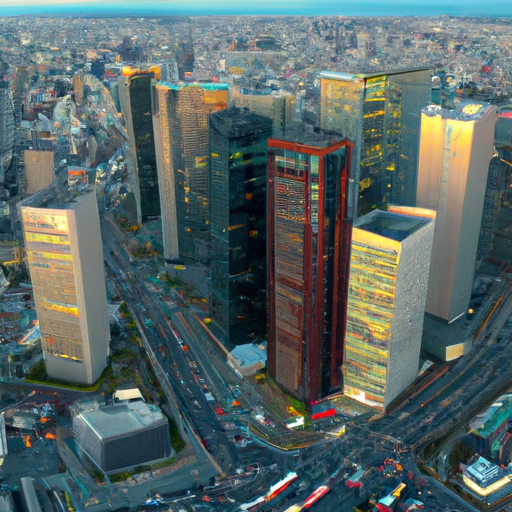
The Growth of Business Travel in Asia Pacific: A Projected Rebound
The COVID-19 pandemic has undoubtedly had a significant impact on the global economy, and the travel industry has been one of the hardest hit. However, as the world slowly recovers from the pandemic, there is a glimmer of hope for the business travel sector in the Asia Pacific region. According to a recent report, business travel in Asia Pacific is projected to rebound strongly, with anticipated spending expected to exceed $800 billion by 2027.
The growth of business travel in Asia Pacific is not a new phenomenon. In recent years, the region has emerged as a major player in the global business travel market. With its rapidly expanding economies and increasing connectivity, Asia Pacific has become an attractive destination for businesses looking to expand their operations and tap into new markets.
However, the COVID-19 pandemic brought business travel to a grinding halt. Travel restrictions, lockdowns, and the fear of contracting the virus forced companies to cancel or postpone their business trips. As a result, the business travel industry in Asia Pacific experienced a sharp decline in 2020, with spending dropping by more than 70%.
But as the world starts to recover from the pandemic, there are signs of a rebound in business travel. With the rollout of vaccines and the easing of travel restrictions, companies are once again starting to plan their business trips. According to the report, business travel spending in Asia Pacific is expected to grow at a compound annual growth rate of 8.6% from 2021 to 2027.
Several factors are driving this projected rebound in business travel. Firstly, the region’s strong economic growth is creating new business opportunities. As countries in Asia Pacific continue to develop and modernize their economies, there is a growing demand for business travel to facilitate trade and investment.
Secondly, the increasing connectivity in the region is making it easier for businesses to travel. The expansion of airports, the development of high-speed rail networks, and the growth of low-cost carriers have made travel more convenient and affordable. This has opened up new markets and made it easier for companies to establish a presence in different countries.
Thirdly, the rise of technology has not diminished the importance of face-to-face meetings. While virtual meetings have become more common during the pandemic, many business executives still believe that in-person meetings are essential for building relationships and closing deals. As a result, there is a pent-up demand for business travel that is expected to drive the rebound in the coming years.
However, the projected rebound in business travel is not without its challenges. The ongoing uncertainty surrounding the pandemic and the potential for future outbreaks could dampen the recovery. Travel restrictions and quarantine requirements could also continue to hinder business travel, especially for international trips.
In conclusion, the projected rebound of business travel in Asia Pacific is a promising sign for the region’s economy. With anticipated spending expected to exceed $800 billion by 2027, the business travel industry is poised for a strong recovery. However, challenges remain, and it will be crucial for governments and businesses to work together to ensure a safe and seamless travel experience. As the world slowly returns to normalcy, business travel will once again play a vital role in driving economic growth and fostering international collaboration.
Anticipated Spending in Business Travel: Exceeding $800 Billion by 2027

Business travel in the Asia Pacific region is expected to experience a significant rebound in the coming years, with anticipated spending projected to exceed $800 billion by 2027. This surge in business travel is a positive sign for the region’s economy and reflects the growing importance of Asia Pacific as a global business hub.
The projected increase in spending on business travel is driven by several factors. Firstly, the region’s strong economic growth has led to an expansion of businesses and increased trade activities. As companies expand their operations and seek new opportunities, the need for business travel naturally increases. This is particularly true for industries such as finance, technology, and manufacturing, which are experiencing rapid growth in the Asia Pacific region.
Additionally, the rise of emerging markets in Asia Pacific has contributed to the growth in business travel. Countries like China, India, and Indonesia have seen a surge in foreign direct investment and are becoming major players in the global economy. As these markets continue to develop, there is a greater demand for business travel to facilitate trade and investment activities.
Furthermore, advancements in technology have made it easier for businesses to connect with partners and clients across borders. However, despite the convenience of virtual meetings and teleconferencing, face-to-face interactions remain crucial for building relationships and sealing deals. As a result, business travel continues to be an essential component of corporate strategies, especially in the Asia Pacific region where personal connections and trust are highly valued.
The projected increase in spending on business travel is not limited to traditional destinations such as Singapore, Hong Kong, and Tokyo. Smaller cities and emerging markets are also expected to see a surge in business travel activities. This is due to the decentralization of business activities and the rise of regional economic hubs. Cities like Kuala Lumpur, Bangkok, and Manila are becoming increasingly attractive for business travelers due to their strategic locations, growing economies, and improved infrastructure.
The anticipated surge in business travel spending also presents opportunities for the hospitality and tourism industry. Hotels, airlines, and other service providers are expected to benefit from the increased demand for accommodation, transportation, and other travel-related services. This will likely lead to job creation and economic growth in the hospitality sector, further contributing to the overall economic development of the Asia Pacific region.
However, it is important to note that the projected rebound in business travel is contingent on several factors. The ongoing COVID-19 pandemic and its impact on travel restrictions and safety protocols could potentially hinder the anticipated growth. Additionally, geopolitical tensions and economic uncertainties could also affect business travel activities in the region.
In conclusion, the Asia Pacific region is poised for a significant rebound in business travel, with anticipated spending projected to exceed $800 billion by 2027. This surge in business travel reflects the region’s strong economic growth, the rise of emerging markets, and the importance of face-to-face interactions in business dealings. While there are potential challenges that could impact this growth, the overall outlook for business travel in Asia Pacific remains positive, presenting opportunities for economic development and job creation in the hospitality and tourism industry.
The Surge of Business Travel in Asia Pacific: A Promising Outlook
The surge of business travel in the Asia Pacific region is expected to bring about a promising outlook for the travel industry. With anticipated spending projected to exceed $800 billion by 2027, it is clear that businesses are recognizing the importance of face-to-face interactions in a globalized world.
One of the key factors driving this surge is the rapid economic growth in the region. As countries like China and India continue to experience strong economic expansion, businesses are expanding their operations and seeking new opportunities in these markets. This has led to an increase in business travel as executives and employees travel to these countries to establish partnerships, attend conferences, and explore potential business ventures.
Furthermore, advancements in technology have made it easier for businesses to connect with partners and clients across the globe. While video conferencing and virtual meetings have become more prevalent, there is still a strong demand for in-person meetings. This is because face-to-face interactions allow for better communication, relationship building, and the ability to read non-verbal cues. As a result, businesses are willing to invest in business travel to ensure the success of their ventures.
The Asia Pacific region is also home to a diverse range of industries, including finance, technology, manufacturing, and tourism. This diversity has created a vibrant business ecosystem, with companies from different sectors collaborating and seeking opportunities for growth. As a result, there is a constant flow of business travelers in the region, attending conferences, trade shows, and industry events.
In addition to economic growth and technological advancements, the rise of the middle class in Asia Pacific has also contributed to the surge in business travel. As more people in the region achieve higher incomes and disposable incomes, there is an increased demand for business travel. This is because individuals are now able to afford to attend conferences, seminars, and training programs to enhance their skills and knowledge.
The surge of business travel in the Asia Pacific region has also led to a boost in the hospitality and tourism industry. Hotels, airlines, and travel agencies are all benefiting from the increased demand for business travel services. As a result, there has been a significant investment in infrastructure and facilities to cater to the needs of business travelers. This includes the development of business hotels, conference centers, and improved transportation networks.
However, it is important to note that the surge of business travel in the Asia Pacific region also presents challenges. One of the main challenges is the need for sustainable travel practices. As the number of business travelers increases, so does the carbon footprint associated with travel. It is crucial for businesses and governments to work together to find innovative solutions to reduce the environmental impact of business travel.
In conclusion, the surge of business travel in the Asia Pacific region is a promising outlook for the travel industry. With anticipated spending projected to exceed $800 billion by 2027, businesses are recognizing the importance of face-to-face interactions in a globalized world. Economic growth, technological advancements, and the rise of the middle class are all contributing factors to this surge. However, it is important to address the challenges associated with increased business travel, such as sustainability, to ensure a sustainable and responsible future for the industry.


